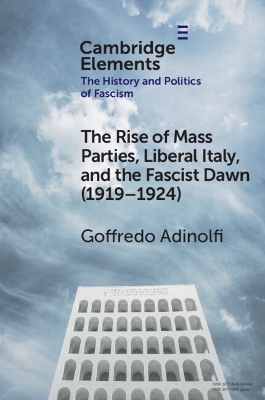
The Rise of Mass Parties, Liberal Italy, and the Fascist Dawn (1919–1924)
Seiten
2025
Cambridge University Press (Verlag)
978-1-009-56439-7 (ISBN)
Cambridge University Press (Verlag)
978-1-009-56439-7 (ISBN)
- Noch nicht erschienen (ca. Februar 2025)
- Portofrei ab CHF 40
- Auch auf Rechnung
- Artikel merken
Focuses on Italy's electoral history from 1919 to 1924 and analyses the process of democratisation. Focuses on the actual strength and the impact of that strength of the parties – socialists, popular and liberal formations - on the whole political system.
Through an in-depth study of the electoral process, the aim of this Element is to analyse the political transformations that occurred in Italy from 1919 to 1924. After the takeover of the low chamber by the mass integration parties in 1919 - Popular and Socialist - concerns grew within the liberal camp. The argument of this Element is that the conservatives failed to adapt and remain competitive in a system characterised by universal suffrage, thereby paving the way for the rise of the fascists. The electoral path to power begins with the political elections of 1921, continues through the renewal of the municipal councils in 1922–23, and concludes with the elections of 1924 when Mussolini managed to take control of the low chamber. The Duce assumed the role of head of the nation, presenting a list of candidates-the Listone-that included members of the Fascist Party and the former politica elite.
Through an in-depth study of the electoral process, the aim of this Element is to analyse the political transformations that occurred in Italy from 1919 to 1924. After the takeover of the low chamber by the mass integration parties in 1919 - Popular and Socialist - concerns grew within the liberal camp. The argument of this Element is that the conservatives failed to adapt and remain competitive in a system characterised by universal suffrage, thereby paving the way for the rise of the fascists. The electoral path to power begins with the political elections of 1921, continues through the renewal of the municipal councils in 1922–23, and concludes with the elections of 1924 when Mussolini managed to take control of the low chamber. The Duce assumed the role of head of the nation, presenting a list of candidates-the Listone-that included members of the Fascist Party and the former politica elite.
Introduction; 1. The November 1919 Elections; 2. Local Elections and the Bologna's Clash: The Rise of Paramilitary Influence; 3. From the 1921 Elections to Mussolini as President; 4. The 1924 Elections; Conclusions; References.
| Erscheint lt. Verlag | 28.2.2025 |
|---|---|
| Reihe/Serie | Elements in the History and Politics of Fascism |
| Zusatzinfo | Worked examples or Exercises |
| Verlagsort | Cambridge |
| Sprache | englisch |
| Themenwelt | Sozialwissenschaften ► Politik / Verwaltung ► Politische Systeme |
| Sozialwissenschaften ► Politik / Verwaltung ► Politische Theorie | |
| Sozialwissenschaften ► Politik / Verwaltung ► Staat / Verwaltung | |
| ISBN-10 | 1-009-56439-0 / 1009564390 |
| ISBN-13 | 978-1-009-56439-7 / 9781009564397 |
| Zustand | Neuware |
| Informationen gemäß Produktsicherheitsverordnung (GPSR) | |
| Haben Sie eine Frage zum Produkt? |
Mehr entdecken
aus dem Bereich
aus dem Bereich
eine Einführung
Buch | Softcover (2023)
Springer VS (Verlag)
CHF 55,95


